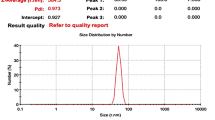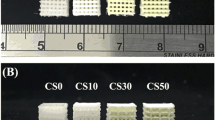Abstract
Polycaprolactone diol is the cornerstone, equipped with polyacrylonitrile and cellulose nanowhiskers (CNWs), of biocompatible and biodegradable polyurethanes (PUs). The solvent casting/particulate leaching technique was employed to contracting foam scaffolds with bimodal sizes from the combination of polyurethane/polyacrylonitrile/cellulose nanowhisker nanocomposites. Sugar and sodium chloride are components used as porogens to develop the leaching method and fabricate the 3D scaffolds. Incorporation of different percentages of cellulose nanowhisker leads to the various efficient structures with biodegradability and biocompatibility properties. All nanocomposites scaffolds, as revealed by MTT assay using mesenchymal stem cell (MSC) lines, were non-cytotoxic. PU/PAN/CNW foam scaffolds were used for osteogenic differentiation of human mesenchymal stem cells (hMSCs). Based on the results, PU/PAN/CNW nanocomposites could not only support osteogenic differentiation but can also enhance the proliferation of hMSCs in three-dimensional synthetic extracellular matrix.
Graphic abstract












Similar content being viewed by others
References
Balazs AC, Emrick T, Russell TP. Nanoparticle polymer composites: where two small worlds meet. Science. 2006;314(5802):1107–10.
Tang E, Cheng G, Ma X. Preparation of nano-ZnO/PMMA composite particles via grafting of the copolymer onto the surface of zinc oxide nanoparticles. Powder Technol. 2006;161(3):209–14.
Cornejo A, Sahar DE, Stephenson SM, Chang S, Nguyen S, Guda T, et al. Effect of adipose tissue-derived osteogenic and endothelial cells on bone allograft osteogenesis and vascularization in critical-sized calvarial defects. Tissue Eng Part A. 2012;18(15–16):1552–61.
Zhao C, Tan A, Pastorin G, Ho HK. Nanomaterial scaffolds for stem cell proliferation and differentiation in tissue engineering. Biotechnol Adv. 2013;31(5):654–68.
Hench LL, Polak JM. Third-generation biomedical materials. Science. 2002;295(5557):1014–7.
Zohora FT, Azim AYMA. Biomaterials as porous scaffolds for tissue engineering applications: a review. Eur Sci J ESJ. 2014;10(21):215–27.
Dhandayuthapani B, Yoshida Y, Maekawa T, Kumar DS. Polymeric scaffolds in tissue engineering application: a review. Int J Polym Sci 2011. https://doi.org/10.1155/2011/290602
Zdrahala RJ, Zdrahala IJ. Biomedical applications of polyurethanes: a review of past promises, present realities, and a vibrant future. J Biomater Appl. 1999;14(1):67–90.
Ganji Y, Li Q, Quabius ES, Böttner M, Selhuber-Unkel C, Kasra M. Cardiomyocyte behavior on biodegradable polyurethane/gold nanocomposite scaffolds under electrical stimulation. Mater Sci Eng C. 2016;59:10–8.
Khalil HA, Bhat A, Yusra AI. Green composites from sustainable cellulose nanofibrils: a review. Carbohyd Polym. 2012;87(2):963–79.
Eichhorn SJ. Cellulose nanowhiskers: promising materials for advanced applications. Soft Matter. 2011;7(2):303–15.
Li B, Yoshii T, Hafeman AE, Nyman JS, Wenke JC, Guelcher SA. The effects of rhBMP-2 released from biodegradable polyurethane/microsphere composite scaffolds on new bone formation in rat femora. Biomaterials. 2009;30(35):6768–79.
Weigel T, Schinkel G, Lendlein A. Design and preparation of polymeric scaffolds for tissue engineering. Expert Rev Med Devices. 2006;3(6):835–51.
Ramakrishna S, Mayer J, Wintermantel E, Leong KW. Biomedical applications of polymer-composite materials: a review. Compos Sci Technol. 2001;61(9):1189–224.
Rezwan K, Chen Q, Blaker J, Boccaccini AR. Biodegradable and bioactive porous polymer/inorganic composite scaffolds for bone tissue engineering. Biomaterials. 2006;27(18):3413–31.
Saïd Azizi Samir MA, Alloin F, Paillet M, Dufresne A. Tangling effect in fibrillated cellulose reinforced nanocomposites. Macromolecules. 2004;37(11):4313–6.
Liu M, Zheng H, Chen J, Li S, Huang J, Zhou C. Chitosan-chitin nanocrystal composite scaffolds for tissue engineering. Carbohyd Polym. 2016;152:832–40.
Siqueira G, Bras J, Dufresne A. Cellulosic bionanocomposites: a review of preparation, properties and applications. Polymers. 2010;2(4):728–65.
Godjevargova T, Dimov A. Permeability and protein adsorption of modified charged acrylonitrile copolymer membranes. J Membr Sci. 1992;67(2–3):283–7.
Wang Z-G, Wan L-S, Xu Z-K. Surface engineerings of polyacrylonitrile-based asymmetric membranes towards biomedical applications: an overview. J Membr Sci. 2007;304(1):8–23.
Saroja N, Shamala T, Tharanathan R. Biodegradation of starch-g-polyacrylonitrile, a packaging material, by Bacillus cereus. Process Biochem. 2000;36(1):119–25.
Shahrousvand M, Mir Mohamad Sadeghi G, Salimi A. Artificial extracellular matrix for biomedical applications: biocompatible and biodegradable poly (tetramethylene ether) glycol/poly (ε-caprolactone diol)-based polyurethanes. J Biomater Sci Polym Ed. 2016;27(17):1712–28.
Norouz F, Halabian R, Salimi A, Ghollasi M. A new nanocomposite scaffold based on polyurethane and clay nanoplates for osteogenic differentiation of human mesenchymal stem cells in vitro. Mater Sci Eng C. 2019;103:109857.
Kucinska-Lipka J, Marzec M, Gubanska I, Janik H. Porosity and swelling properties of novel polyurethane–ascorbic acid scaffolds prepared by different procedures for potential use in bone tissue engineering. J Elastomers Plast. 2017;49(5):440–56.
Shahrousvand M, Hoseinian MS, Ghollasi M, Karbalaeimahdi A, Salimi A, Tabar FA. Flexible magnetic polyurethane/Fe 2 O 3 nanoparticles as organic-inorganic nanocomposites for biomedical applications: properties and cell behavior. Mater Sci Eng C. 2017;74:556–67.
Burg KJ, Porter S, Kellam JF. Biomaterial developments for bone tissue engineering. Biomaterials. 2000;21(23):2347–59.
Lee M, Heo MH, Lee H-H, Kim Y-W, Shin J. Tunable softening and toughening of individualized cellulose nanofibers-polyurethane urea elastomer composites. Carbohyd Polym. 2017;159:125–35.
Karageorgiou V, Kaplan D. Porosity of 3D biomaterial scaffolds and osteogenesis. Biomaterials. 2005;26(27):5474–91.
Grenier S, Sandig M, Mequanint K. Polyurethane biomaterials for fabricating 3D porous scaffolds and supporting vascular cells. J Biomed Mater Res Part A. 2007;82(4):802–9.
Shahrousvand M, Sadeghi GMM, Shahrousvand E, Ghollasi M, Salimi A. Superficial physicochemical properties of polyurethane biomaterials as osteogenic regulators in human mesenchymal stem cells fates. Colloids Surf B. 2017;156:292–304.
Cherian BM, Leão AL, de Souza SF, Costa LMM, de Olyveira GM, Kottaisamy M, et al. Cellulose nanocomposites with nanofibres isolated from pineapple leaf fibers for medical applications. Carbohyd Polym. 2011;86(4):1790–8.
Sabir MI, Xu X, Li L. A review on biodegradable polymeric materials for bone tissue engineering applications. J Mater Sci. 2009;44(21):5713–24.
Barrioni BR, de Carvalho SM, Oréfice RL, de Oliveira AAR, de Magalhães PM. Synthesis and characterization of biodegradable polyurethane films based on HDI with hydrolyzable crosslinked bonds and a homogeneous structure for biomedical applications. Mater Sci Eng C. 2015;52:22–30.
Anderson HC, Harmey D, Camacho NP, Garimella R, Sipe JB, Tague S, et al. Sustained osteomalacia of long bones despite major improvement in other hypophosphatasia-related mineral deficits in tissue nonspecific alkaline phosphatase/nucleotide pyrophosphatase phosphodiesterase 1 double-deficient mice. Am J Pathol. 2005;166(6):1711–20.
McComb RB, Bowers GN Jr, Posen S. Alkaline phosphatase. Berlin: Springer; 2013.
Kim BS, Kim JS, Sung HM, You HK, Lee J. Cellular attachment and osteoblast differentiation of mesenchymal stem cells on natural cuttlefish bone. J Biomed Mater Res Part A. 2012;100(7):1673–9.
Whyte MP. Hypophosphatasia and the role of alkaline phosphatase in skeletal mineralization. Endocr Rev. 1994;15(4):439–61.
Nam S, Jin Y-H, Li Q-L, Lee K-Y, Jeong G-B, Ito Y, et al. Expression pattern, regulation, and biological role of runt domain transcription factor, run, in Caenorhabditis elegans. Mol Cell Biol. 2002;22(2):547–54.
Lynch MP, Stein JL, Stein GS, Lian JB. The influence of type I collagen on the development and maintenance of the osteoblast phenotype in primary and passaged rat calvarial osteoblasts: modification of expression of genes supporting cell growth, adhesion, and extracellular matrix mineralization. Exp Cell Res. 1995;216(1):35–45.
Droscha CJ, Diegel CR, Ethen NJ, Burgers TA, McDonald MJ, Maupin KA, et al. Osteoblast-specific deletion of Hrpt2/Cdc73 results in high bone mass and increased bone turnover. Bone. 2017;98:68–78.
Jahn K, Bonewald L. Bone cell biology: osteoclasts, osteoblasts, osteocytes. Pediatr Bone Biol Dis. 2012;5:43–71.
Dabbs DJ. Diagnostic Immunohistochemistry E-Book. Amsterdam: Elsevier; 2013.
Acknowledgements
The cells used for experiments were kindly provided by Stem Cell Technology Research Center (Iran).
Funding
The work was not supported by any Department.
Author information
Authors and Affiliations
Corresponding authors
Ethics declarations
Conflict of interest
All authors declare that they have no conflict of interest.
Ethical approval
This article does not contain any studies with human participants or animals performed by any of the authors.
Additional information
Publisher's Note
Springer Nature remains neutral with regard to jurisdictional claims in published maps and institutional affiliations.
Rights and permissions
About this article
Cite this article
Padash, A., Halabian, R., Salimi, A. et al. Osteogenic differentiation of mesenchymal stem cells on the bimodal polymer polyurethane/polyacrylonitrile containing cellulose phosphate nanowhisker. Human Cell 34, 310–324 (2021). https://doi.org/10.1007/s13577-020-00449-0
Received:
Accepted:
Published:
Issue Date:
DOI: https://doi.org/10.1007/s13577-020-00449-0




